

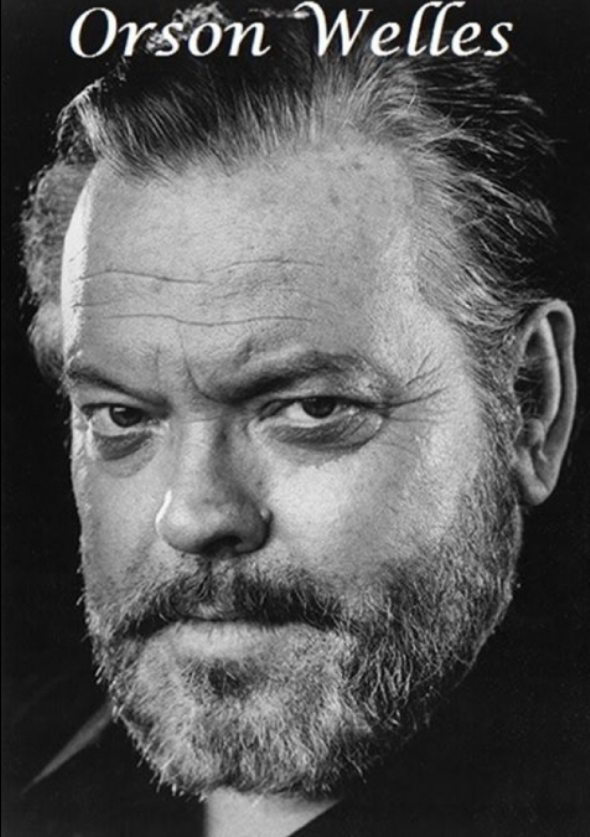




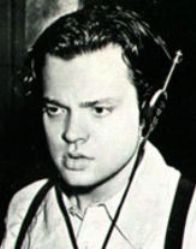
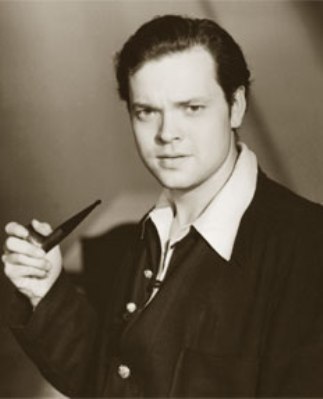
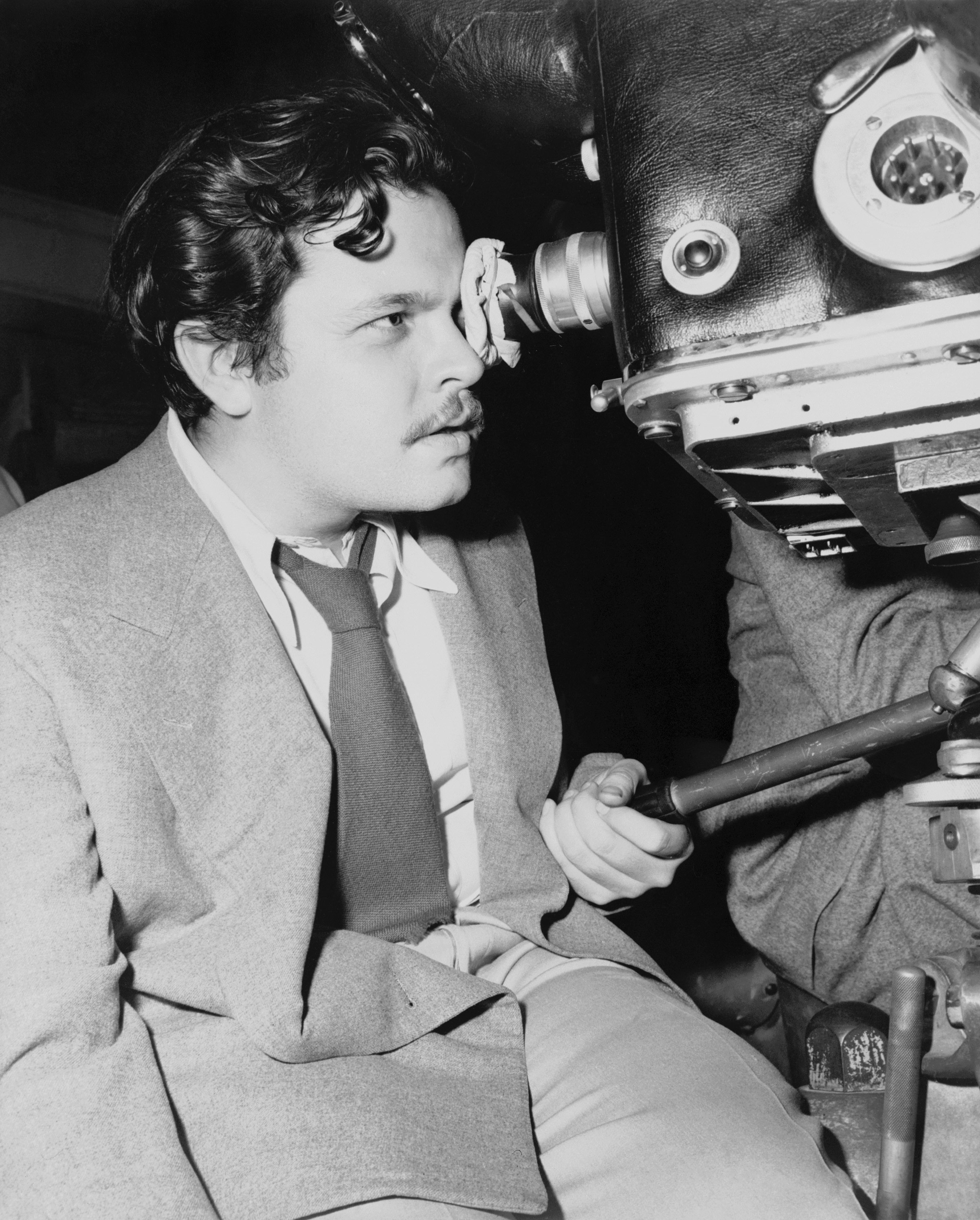




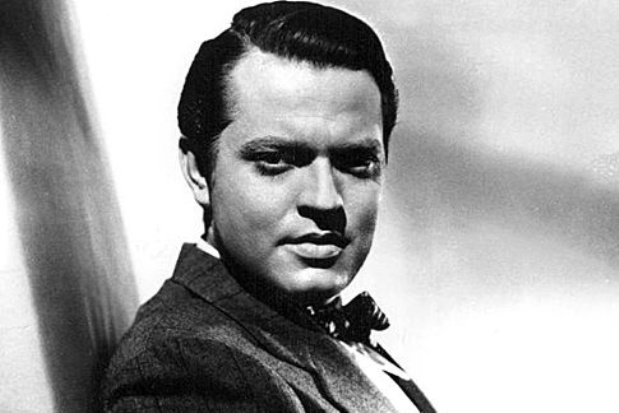
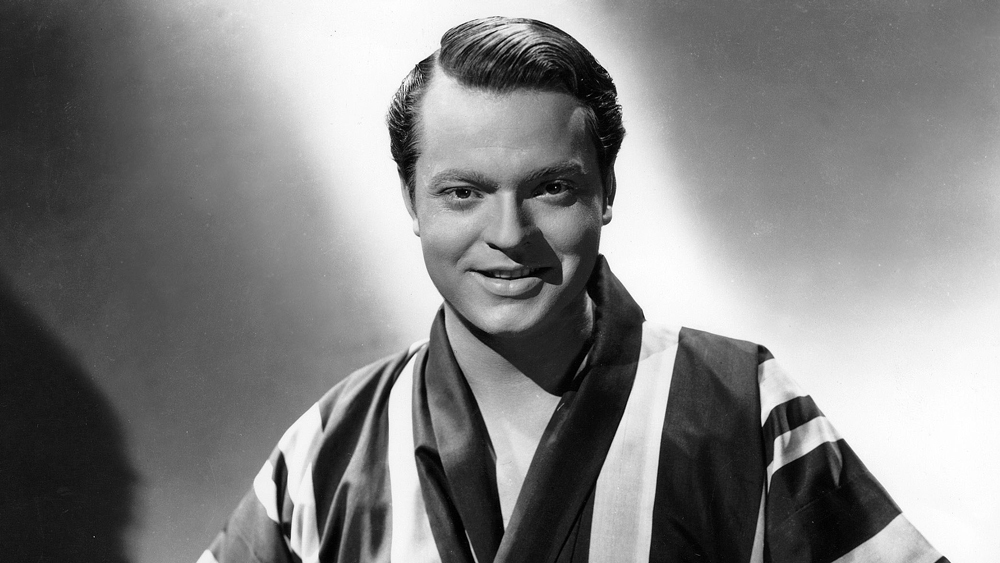
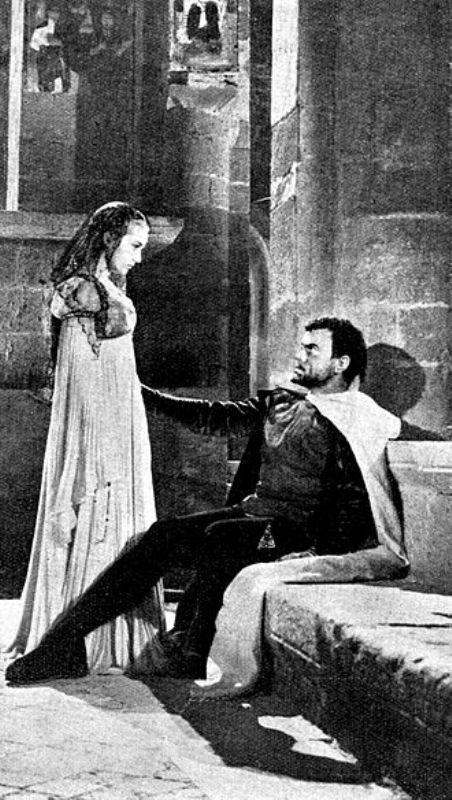
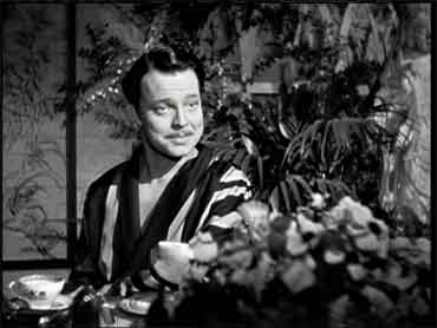
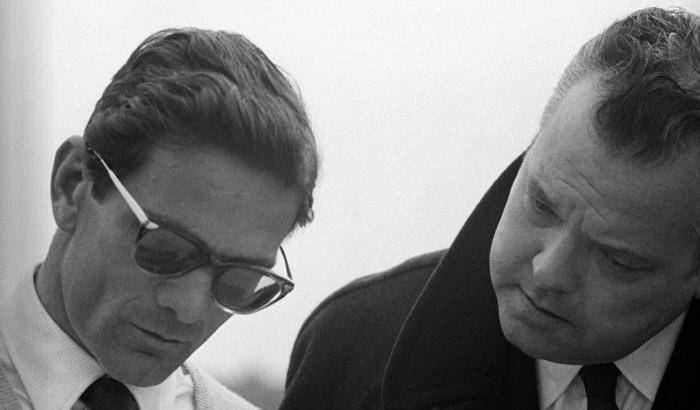
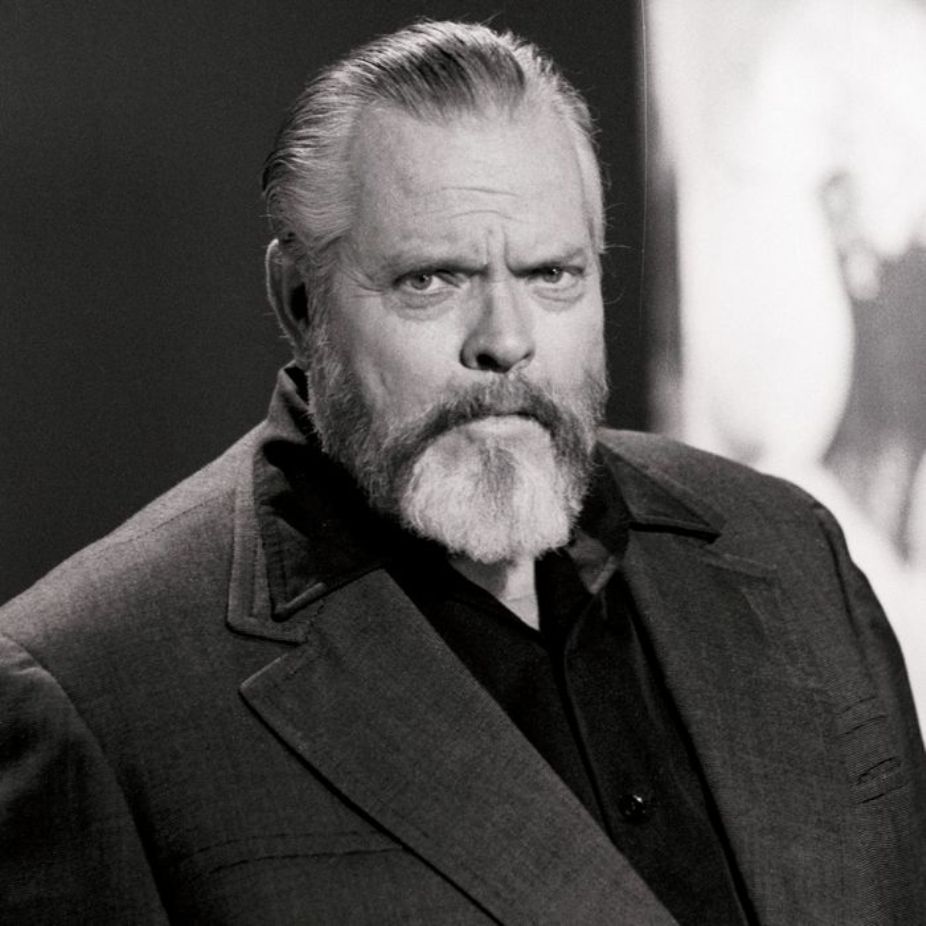
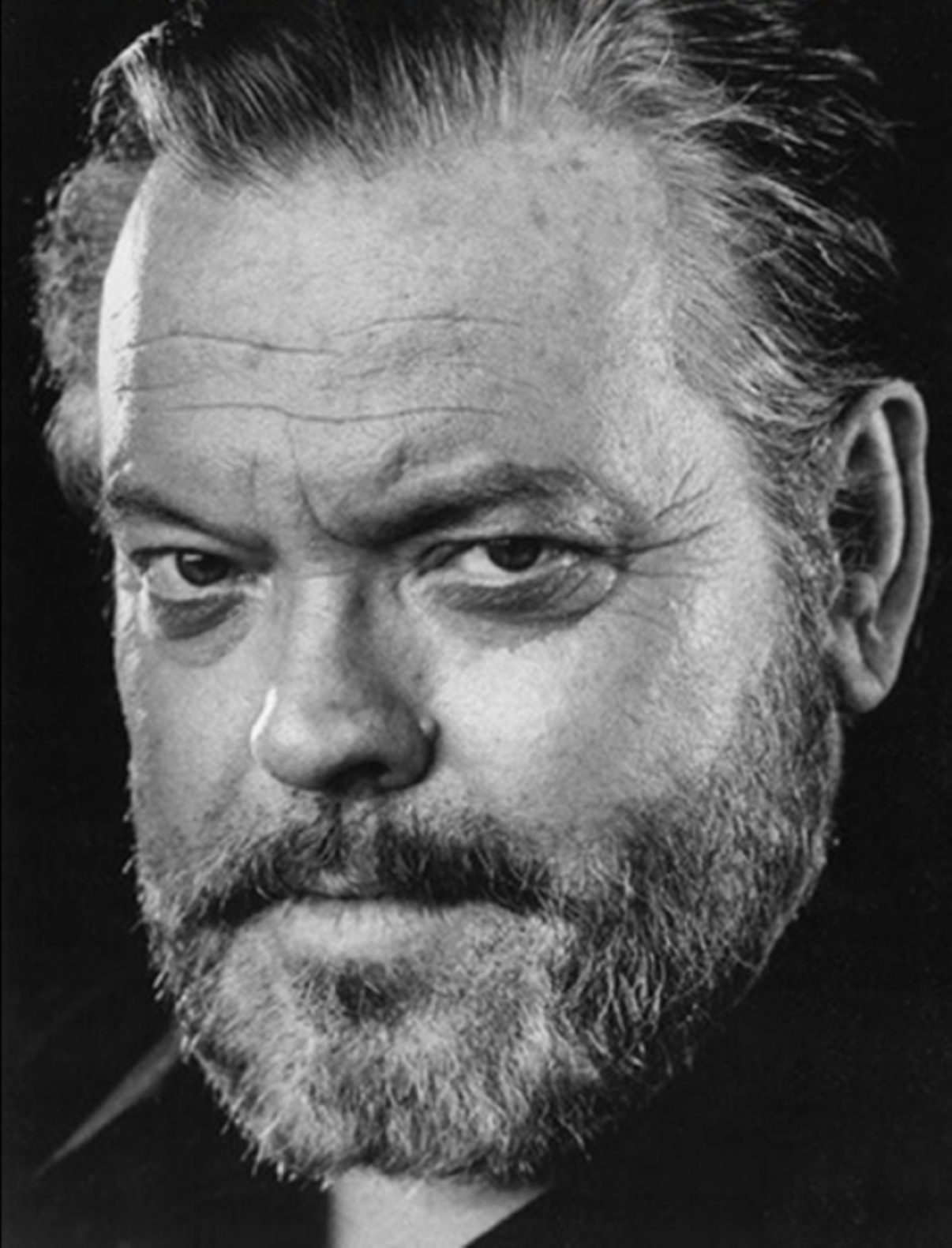


![]() MAY 30, 2021
MAY 30, 2021
of Maria Anna Avveduto
ORSON WELLES
George Orson Welles known simply with Orson Welles was born in Kenosha on
May 6, 1915 and disappeared in Los Angeles on October 10, 1985.
He is considered one of the most versatile and innovative artists of the
twentieth century in the theater, radio and cinema fields.
He achieved success at the age of twenty-three thanks to the radio show "War
of the Worlds" which caused panic in much of the United States by making the
population believe that they were under attack by the Martians.
This unusual debut gave him stardom and landed him a one-film-a-year deal
with the film production company RKO.
Despite this advantageous clause, only one of the planned projects could see
the light: "Fourth Estate" of 1941, Welles' greatest film success still
considered today one of the best films in the history of cinema.
Welles's subsequent career was hampered by a long series of difficulties and
inconveniences that prevented him from continuing to work in Hollywood and
that forced him to move to Europe, where he continued to try to make his
works, financing himself mainly through appearances in other people's films.
.
Among his many projects, Welles managed to make and direct numerous films
such as: "Macbeth" of 1948, "Othello" of 1952, "Infernale Quinlan" of 1958,
"The trial" of 1962 and "F as false" of 1975.
His fame increased after his death in 1985.
Orson Welles is considered one of the greatest film and theater directors of
the 20th century.
He received the Palme d'Or at the Cannes Film Festival in 1952, which at the
time was called "Gran Prix du Festival". He obviously received other honors
including his 1971 Lifetime Achievement Oscar.
In 2002 he was voted the best director of all time by the British Film
Institute.
The American Film Institute ranked Welles in sixteenth place among the
greatest stars in the history of cinema.
“I've had better luck than anyone else. Sure, I've also been more
unfortunate than anyone else in the history of cinema, but that's the order
of things. I had to pay for having had the greatest fortune in the history
of cinema ... », this is one of Orson Welles' famous phrases.
As we have already mentioned, Orson Welles was born in Kenosha, Wisconsin,
the second son of his family.
His mother Beatrice Ives was a pianist who had served a sentence for
strongly radical political positions.
His father Richard Welles was the owner of a chain of van factories and an
amateur inventor, descended from a wealthy Virginia family.
From birth, Orson's wealthy parents gave him an unconventional education and
treated him as the child prodigy of the family, directing his precocious
talent towards different artistic forms including the piano and painting.
Welles made his very first theatrical appearance at age three as an extra in
the opera "Samson and Delilah" performed at the Chicago Opera.
Later he played the part of the child in a version of Madame Butterfly.
In 1919 his parents separated and Orson followed his mother to Chicago,
thanks to which he frequented artistic and intellectual circles.
Suddenly on May 10, 1924, mother Beatrice Welles died at forty-three.
The painful loss had profound effects on the artistic choices of Orson
Welles who returned to live with his father and abandoned his musical career
forever.
Doctor Maurice Bernstein, an old family friend of the Welles, stimulated the
boy's love for the theater, giving him a magic lantern, a box of colors and
a puppet theater, with which Orson began to try his hand at the staging of
shows all his own, in which he provided the voice to all the characters from
time to time.
At the age of ten, during his early schooling period in Madison, Wisconsin,
Welles devoted himself to school student plays and directed and starred in
"Dr. Jekyll and Mr. Hyde," his first show at Camp Indianola. He then went on
to study at Todd School in Woodstock in Illinois, an avant-garde school run
by Professor Roger Hill.
During the five years spent at the Todd School, Welles continued his
theatrical and literary experiences, acting in Shakespearean tragedies and
historical dramas and even venturing into magic and illusionism artistic
forms that always remained among his interests.
He also directed a version of Shakespeare's "Julius Caesar" in which he won
the Chicago Drama Association award for best school play.
In 1930 his father died, leaving 15-year-old Orson under the tutelage of Dr.
Bernstein.
The following year Orson graduated from Todd School and after briefly
attending the "Chicago Art Institute", he obtained permission from Dr.
Bernstein to postpone enrollment at Harvard University and leave for Ireland
for some sort of " artistic tour "with the main aim of making it into
painting. Traveling in a donkey-drawn cart, which he often used as a roof
for the night, Welles first visited the Aran Islands and then moved to
Dublin where he exhausted his finances so much that he was forced to sell
his own donkey.
Welles decided to try the theater route and then introduced himself to
Hilton Edwards, director of the "Gate Theater in Dublin", claiming to be a "famous
New York actor" and getting a gig among the main actors.
The first interpretation of him was Duke Karl Alexander of Württemberg in
the theatrical edition of Jew Süss.
In 1933, after working for two years as a director and actor in various
shows including at the Abbey Theater, Welles decided to move to London to
try his hand at English theater but he was refused a work permit.
He was forced to return to the United States where he made plays at the Todd
School and collaborated with Roger Hill on a series of essays on Shakespeare
that appeared in the Everybody's Shakespeare editorial series.
In 1934 the nineteen year old Welles married the heiress Virginia Nicolson
with whom he will have a daughter who was born in 1937 who was given the
unusual name of Christopher.
At Todd School he shot his first short film "The Hearts of Age", in which he
played the grotesque figure of Death and in which his wife Virginia also
took part in the role of an elderly gentlewoman.
This short 16 mm silent film was inspired by the work of directors of the
time from Erich von Stroheim to Luis Buñuel. Already in this short film we
can see how the composition of the image clearly characterizes Welles's
directing technique.
In just four minutes the film already presented all the elements of Welles'
future film production.
The accuracy of the make-up was also a fundamental element and revealed a
trend that Welles developed throughout his acting career, that of camouflage
and transvestism with the use of elaborate make-up techniques.
In "The Hearts of Age", Welles appeared as an old man even though he was
only 19 years old and afterwards he always paid particular attention to
make-up, already starting with the Fourth Estate.
In 1934 Welles moved permanently to New York and made his Broadway debut
where he played the part of Tibaldo in "Romeo and Juliet", in the company of
Katharine Cornell, interpreter of the role of Juliet.
Welles started working on the radio.
In the same period he undertook the artistic collaboration with the director
and theatrical producer John Houseman staging the show "Panic".
The period of Welles's success coincided with a moment of strong social
commitment on the part of the American theatrical world.
Despite some opposition from more conservative political circles, Welles and
Houseman decided to perform Marc Blitzstein's musical "Cradle with Rock"
considered the first "proletarian drama" in the history of American theater.
However, the government tried to prevent the staging and on the evening of
the premiere, that is June 16, 1937, the cast found the entrance to the
Maxine Elliott Theater barred and the building occupied by the police.
This inconvenience did not discourage Welles, who improvised the show on the
spot outside the theater to entertain the spectators until the problem was
resolved.
The Venice Theater was rented twenty-one blocks away and the public was
invited to go to the new theater, where the show was performed without
scenery or costumes, with the performers acting along the aisles of the
stalls as union regulations forbade the cast to enter the scene.
Blitzstein alone occupied the stage, reciting the captions that accompanied
the stage movements and playing the music on the piano.
The show was so successful that it was repeated in this improvised form
until the following July 1st.
With the Federal Theater experience closed, Welles and Houseman founded a
new prose company, the "Mercury Theater" with the aim of staging classical
and modern works.
The company (which the young director will direct until the end of his
Hollywood period) debuted with a version of Shakespeare's "Julius Caesar"
set in fascist Italy, a performance that immediately aroused various
controversies.
In the summer of 1938 Welles and the "Mercury Theater" company became a
daily presence on CBS radio broadcasts, with the Mercury Theater on the Air
program featuring audio reinterpretations of classics or popular literary
works.
Welles knew that CBS was broadcasting on frequencies close to those of the
most popular NBC, where the popular broadcasts of comedian and ventriloquist
Edgar Bergen and his puppet Charlie McCarthy were airing at the same time,
but he also knew that Bergen, at a very specific time of his broadcast, he
always broadcast a musical cut during which the audience tended to change
station: it was at that moment that Welles decided to land his Martians.
The choice proved effective as the United States plunged into chaos.
According to the testimony of many collaborators including personal
assistant Alland, CBS executive Davison Taylor swooped into the recording
room after 15 minutes and exclaimed to Welles, "By God, stop this thing!
People out there are crazy. ! ".
Soon after Welles replied to CBS CEO Paley (who came in slippers and a
bathrobe), who ordered him to shut down the show: "Interrupt? Why? They must
be afraid, let me continue!" following.
"For what we did I should have ended up in jail, but on the contrary, I
ended up in Hollywood," he said
Orson Welles.
Before his real film debut in "Fourth Estate", Orson Welles had already
directed a film: "Too Much Johnson" a medium-length film shot in 1938 which
was destined to be included in the homonymous theatrical farce which,
however, was never put on stage.
The only copy of that medium-length film was lost in 1970 in the fire of his
villa in Madrid. “It was a good movie. We had created a dream Cuba in New
York. I looked at it 4 years ago and the print was in great condition. You
know, I never put it on. I thought I'd put it together and give it to Joe
Cotten as a Christmas present for a few years, but I never did, ”Orson
Welles said.
A copy of the film was found on 7 August 2013, in a warehouse in Pordenone.
Restored by the Cineteca del Friuli, the work was screened on 9 October 2013
as part of the Silent Film Days event.
On August 21, he signed the most profitable contract ever offered by a
studio with RKO Pictures.
As an actor, screenwriter, director and producer, Welles would receive an
estimated $ 50,000 upfront payment in addition to 20% of gross proceeds for
the making of three films.
The contract also granted him absolute artistic freedom, a freedom that
anyone in Hollywood would have wanted and that was probably helping to fuel
the film's envy of the newcomer.
For his first project at RKO, Welles began work on an adaptation of Joseph
Conrad's Heart of Darkness.
The script, which was made in a short time, included some variations from
the novel.
The role of female protagonist was entrusted to the actress Dita Parlo while
part of the cast was composed of actors from the "Mercury Theater", who,
thanks to Welles, had in turn obtained a contract with RKO and would soon
appear in " Fourth Estate ". However, the project failed due to multiple
circumstances.
Parlo was detained in France on charges of collaborationism, the RKO was not
willing to place trust in such a revolutionary directing technique while the
budget of the film turned out to be too high given the need to set up a set
that reconstructed African environments. .
Without losing heart, Welles turned to his second project with RKO and
decided to make "Smiler with a Knife" a detective film.
Also in this case, the film never saw the light, it is said for the
renunciation by the two chosen interpreters, Carole Lombard and Rosalind
Russell, who were afraid of ruining their reputation by participating in a
film directed by a novice director. .
As Welles later declared, Carole Lombard was actually friends with him and
she supported him, but the actress's production company did not give her
permission to participate in the film.
We arrive at "Fourth Estate".
«Fourth Estate tells the story of the investigation made by a journalist
named Thompson to discover the meaning of Charles Foster Kane's last words.
For his opinion is that a man's last words must explain his life. Maybe it's
true. He will never understand what Kane meant, but the audience does. His
investigation leads him to five people who knew Kane well, who loved him and
hated him. They tell him five different stories, each of them very partial,
so that the truth about Kane can only be deduced - as indeed any truth about
an individual - from the sum of everything that has been said about him.
According to some, Kane only loved his mother, according to others she only
loved his newspaper, only his second wife, only himself. Maybe he loved all
these things, maybe he didn't love any of them. The public is the only judge.
Kane was both selfish and disinterested, an idealist and a cheater at the
same time, a very big man and a mediocre man. It all depends on who talks
about it. He is never seen through an author's objective eye. On the other
hand, the purpose of the film lies in proposing a problem rather than
solving it. », Orson Welles recounts in his voice.
As Welles stated, the third film under the contract with RKO began to take
shape as early as the planning of "The Smiler with a Knife".
In addition to Welles, John Houseman and new hire Herman J. Mankiewicz also
worked on the script.
The film was originally called "Welles1", then passed to be called
"American", until it took its definitive title, "Citizen Kane" literally
"Citizen Kane" in Italian instead "Quarto power".
The film was defined by the filmmaker Fracois Truffaut "the film of films
that inspired the debut of the greatest number of directors and actors".
This time Welles aimed to write a completely original subject.
The subject was inspired by the figure of the press tycoon William Randolph
Hearst and the plot of the film seems to echo many references to Hearst's
life.
The story tells of Kane that despite the large inherited possessions, he is
almost exclusively interested in his small newspaper and expands it to
become a national circulation publication, creating an editorial empire
whose stances will be anything but impartial, so as Hearst was known for his
battles and crusades, and in his youth he had attacked the transport trust.
Kane marries twice, the second with an actress-singer-dancer (Hearst was
famously linked to actress Marion Davies), and unsuccessfully attempts to
enter politics; the realization of Xanadu recalls the residence that Hearst
had built (the castle of San Simeon, which also became famous for the social
events linked to Hollywood and the world of cinema);
Kane buys all kinds of works of art just for the sake of owning them,
exactly as Hearst did with his obsession with collecting that drove him to
buy objects that he then left packed in crates; in the last years of his
life Kane retires to private life, isolating himself to avoid any human
contact.
Other interpretations instead believe that the film may have been inspired
by Jules Brulatour, owner of Kodak and pioneer of the film industry, or by
the eccentric producer Howard Hughes, as reported in F as false.
Welles himself declared to Peter Bogdanovich that in order to outline the
protagonist of the story, Hughes was first thought of to pass immediately to
the masters of the printed word and to the tycoons of the end of the
century.
Welles entrusted most of the main roles in the film to actors with whom he
had previously worked at the "Mercury Theater" and who came from the radio
experience: Joseph Cotten, Agnes Moorehead, Everett Sloane, Ray Collins,
George Coulouris, Erskine Sanford and Paul Stewart.
The script for "Quarto Power" took over three months of work and shooting
began on July 30, 1940, while editing began on October 23 of the same year.
The release date of Fourth Estate originally scheduled for February 14,
1941, was postponed several times, so much so that Welles threatened RKO
with contractual default for this delay.
The controversy stirred the production company, which was trying to exploit
the publicity created by the controversy to launch the film, which premiered
for printing on April 9, 1941.
The film was first shown to New York audiences at RKO Palace on Broadway on
May 1, 1941.
Fourth Estate struggled to obtain great public success, mainly due to the
boycott undertaken by the periodicals of the Hearst publishing empire which
did not allow the film to be properly distributed in major theaters and
chains.
On the contrary, critical reviews instead welcomed the film as one of the
greatest cinema masterpieces of all time.
With Fourth Power, Orson Welles unhinges the practices of the so-called
"cinema of the origins" by re-establishing, in fact, the techniques of film
shooting relying on artistic innovations in narration, in shooting
techniques and in the use of symbolism.
Reworking mechanics, optics and lighting, he reconstructs and improves the
style of masters of the "first cinema" such as David Wark Griffith from whom
he draws inspiration and suggestions.
With the role of the protagonist Charles Foster Kane, Welles also
demonstrated his sensitivity and interpretative ability by covering all
phases of the character's existence.
Of fundamental importance for Welles's interpretation was also the skill of
the make-up artist Maurice Siederman, whose commitment managed to make the
various passages of Kane's existence, from twenty to seventy-seven years
old, extremely convincing.
But Orson Welles was also made up in the scenes that portray Kane as a young
man.
But the most innovative aspect of the film is the use, conscious and
systematic for the first time, of the depth of field (deep focus) and the
sequence shot.
The first technique was studied and deepened by the famous director of
photography Gregg Toland who resorted to special lenses to which were
applied fluted metal rings (or "Waterhouse stops") that allowed to vary the
depth of field while the camera was in function, and the use of
ultra-sensitive film that was starting to be placed on the market at the
beginning of the 1940s.
At the writing level, the main innovation consists instead in the recourse
to the systematic use of flashbacks, contrary to the classic style of films.
According to the rankings of the AFI and the BFI and many other critics,
"Fourth Estate" is considered the "Most Beautiful Film in the History of
Cinema".
The second film Welles directed for RKO in 1942 was the more sober and
traditional "Pride of the Amberson" original title "The Magnificent
Amberson" adapted from the Pulitzer Prize winning novel of the same name by
Booth Tarkington.
With this film, the executives of the production company pinned their hopes
of recovering the investments lost with the partial commercial flop of the
previous film.
Welles considered this film even better than "Fourth Estate", considering it
a more mature, more studied realization and with a directing technique
already different from the first film.
Basically, the film had all the prerequisites to become a great success and
a great cinematic work of art but even in this case Welles found a road full
of difficulties before him as new clashes with the producer were prepared.
During filming, the US government asked Welles to make a documentary film
about South America.
Welles then left the country to begin filming "It's All True", after having
edited the first draft copy of "The Pride of the Ambersons", thinking he
could continue to telegram the final instructions to his collaborators.
At this point the RKO, already in financial difficulty and frightened by a
possible new commercial failure, took control of the film from the staff of
Mercury Production in Welles and cut more than 50 minutes of footage, while
some scenes including the final ones that came filmed from scratch and added
or replaced to what was left of the first version.
The cut original film, including the original ending Welles shot, was
irretrievably lost.
The RKO intervention that strongly attenuated the nostalgic and bittersweet
tones of "The Pride of the Ambersons" was only the first in a long series of
persecutions and harmful interference from producers, which Welles will have
to face throughout his career in Hollywood.
During the production of The Pride of the Ambersons, Welles was
simultaneously engaged as an actor on the set of another film, the spy-story
"Terror on the Black Sea", based on a novel by Eric Ambler and shot
simultaneously in a nearby theater. of laying.
Written and performed with Joseph Cotten, the film was hastily made at night
and did not convince the production company that it will only release it in
August 1943, limiting its duration to 71 minutes and obtaining little
success.
Welles, who in the film plays the bloodthirsty and caricatured Colonel Haki,
head of the Turkish secret police, at first succeeded in obtaining from the
RKO the right to turn the ending and to integrate the story with the
narrator of Joseph Cotten but this attempt did not help. anyway to the
movie.
At the outbreak of World War II, many artists engaged in politics or even
enlisted, but Welles tried to avoid military service.
It was later discovered that Welles had avoided military service through a
letter addressed to Metro Goldwin Meyer dated April 28, 1943 and addressed
to the Office of War Information in which the director requests an exemption
from military service to participate in a film production based on "War and
peace "by Tolstoy, however, never realized.
In the aftermath of the Japanese attack on Pearl Harbor - with a view to
launching a propaganda action in Latin America for fear of a possible Nazi
influence in those countries, Welles was consulted by the United States
government who instructed him to reach the Brazil to shoot a film about the
Rio de Janeiro Carnival thus compromising the continuation of the director's
work for both "The pride of the Ambersons" and "Terror on the Black Sea".
Welles left for Brazil where the carnival started on February 13th.
Meanwhile, the RKO production house underwent a change in the top
management: George Schaefer, protector of Welles, was replaced by Charles J.
Koerner, who fired the director and decided to recall the crew from Brazil
revoking the availability of the residual funds.
With the film's failure, all the work was left unused and was deposited in
the RKO archives.
The only material that can be viewed today is contained in "It's All True",
or in the documentary of the same name that tells the making of the film
released in the nineties.
For some years, during the period of the Second World War, Welles remained
away from the world of cinema, dedicating himself to radio propaganda
broadcasts for CBS and, in particular, to activities of a political nature
such as a series of lectures on the nature of fascism and the support for
the administration of US President Roosevelt for whom he wrote several
political speeches.
Meanwhile Welles, who in 1939 had divorced his first wife Virginia Nicolson
and who had had a subsequent relationship with the Mexican actress Dolores
del Río, in 1943 remarried to Rita Hayworth, whose interpretation in the
1946 Gilda will consecrate her as one of the major post-war sex symbols.
From his marriage to Hayworth in 1944, a daughter was born whom they named
Rebecca who died in 2004.
Welles returned to film thanks to producer David O. Selznick who hired him
to play the costume drama "The Forbidden Door" in 1944 based on the novel
Jane Eyre, opposite Joan Fontaine.
Welles's subsequent film engagement represented one of the most curious and
fascinating moments in his career.
In the 1944 film "The Ship of Death", a typical Hollywood product of the war
period composed of sketches and entertaining musical numbers, Welles
resorted to an ancient passion of his: illusionism.
After the interpretation of a veteran of the First World War in the
sentimental drama "Count only the future" of 1945, opposite Claudette
Colbert.
Welles managed to make three more films in Hollywood: in the first, "The
Stranger" of 1946, Welles directed Loretta Young and Edward G. Robinson,
also playing the role of the protagonist, a former Nazi who tries to hide
his past under the identity of a professor who teaches in a college in a
small town in Connecticut.
In 1946 Welles returned to the theater with "Around the World", a musical
adaptation of "Around the World in Eighty Days".
The show achieved great critical acclaim but the poor audience response left
Welles in dire financial conditions and forced him to reach a hasty
agreement with Columbia producer Harry Cohn to direct "The Lady of
Shanghai", a curious mix of drama and noir elements, in which he also
starred in the role of the protagonist, the sailor Michael O'Hara, and
entrusted to his wife Rita Hayworth the character of Elsa Bannister, a false
and amoral femme fatale.
The release of the film, now considered a "classic", was blocked by Harry
Cohn, horrified by the possible reaction of the public in the face of the
drastic transformation of Hayworth's image.
"The Lady from Shanghai" will only be released in 1948 at the time Welles
and Hayworth filed for divorce after a five-year marriage.
Hayworth later praised the film on more than one occasion, considering it
one of the most beautiful of her career and claiming to have strongly
believed in her ex-husband's abilities, trusting her genius without fear.
After his experience in the noir genre, in the summer of 1947 Welles devoted
himself to the film adaptation of Shakespeare's "Macbeth" of which he was
director and interpreter, obtaining from the producer "Republic Pictures" a
time of only 23 days to finish the production.
Welles had personally designed the sets, but they turned out to be over
budget so he had to be content with making use of makeshift backgrounds like
the old salt mine usually used as a set for Republic westerns.
In the battle sequences, Welles used cameramen as extras, dressing them only
on their backs to film them during close-ups of the fight. Despite the
limited technical means and time restrictions, Welles' version of Macbeth is
to be considered partially successful but it was not enough to avoid the
mediocre conclusion of the first Hollywood phase of his career.
In 1948 Welles definitively left the Californian town and moved to Europe
where he began to focus on a new transposition of a Shakespearean play,
Othello, which he intended to direct and interpret.
The need to finance this project forced him to accept some parts in American
films made in Europe, such as "Cagliostro" of 1949, "The prince of the
foxes" of 1949 and "The black rose" of 1950, the last two alongside Tyrone
Power. .
These are costumed films, with redundant scenographies, in which Welles
produced bored interpretations of intriguing characters weighed down by
excessive frills.
In 1949, Welles landed a role that proved to be of fundamental importance to
his career and in which he will often be identified in the future, that of
Harry Lime in "The Third Man" (The Third Man, 1949), directed by Carol Reed
and written by the British writer Graham Greene, who will later draw a
successful novel from the film.
Set in post-war Vienna, the film revolves around the mysterious figure of
Harry Lime, an ignoble adventurer who traffics in adulterated penicillin in
a city devastated by war events.
The film was a huge success with the public and the charismatic presence of
Welles, who appears for a few minutes but whose cynical and cheeky character
is constantly mentioned throughout the film, helped to consolidate its
popularity, already strengthened in the meantime since the advertised
marriage. with Rita Hayworth.
With the realization of Otello in 1952, which required almost three years of
work, Welles began his adventure as a director in Europe, facing a long
series of professional difficulties, such as the constant need to find the
necessary funds, the failure of the manufacturer. of the film, the "Scalera
Film" of Rome.
Shot on location in Mogador and Safi, on the Moroccan coast, in Venice and
in Tuscania, in 1952 Welles' Otello won the Palme d'Or at the Cannes Film
Festival (in ex equo with Renato Castellani's "Two soldi of hope" ),
attending as a representative of the United States.
Subsequent engagements saw Welles split between some European productions
shot in England, France and Italy.
In Italy he participated as an actor in the 1953 film "The man, the beast
and the virtue" directed by Steno and played alongside Totò.
He also began working for television, directing two series for the British
BBC and returning to New York in 1953 for a version of "King Lear" set to
air as part of the CBS television series "Omnibus".
With "Confidential Report" of 1955, Welles returned to film directing,
choosing a theme in some ways similar to "Fourth Estate", or the story of
Mr. Gregory Arkadin, a powerful enriched man who tries to get rid of anyone
who can discover the infamous secrets of its past and the shameful origins
of its financial power.
The role of Arkadin's daughter Raina was played by an Italian actress,
Countess Paola Mori who in May 1955 became the third Mrs. Welles.
In November of the same year their daughter Beatrice was born.
After nearly ten years away, Welles returned to Hollywood in 1957.
His appearance of him become massive in him made him look older than his 42
years and now precluded those romantic roles that he had faced in the
forties.
In his first two films shortly after his return, Welles played two "South
American" figures: in 1957's "The Rio Grande Tragedy" he plays Virgil
Renchler, an evil landowner who despoticly runs a large ranch in the
Southwest and clashes with the local sheriff (Jeff Chandler); in the 1958
film "The Long Hot Summer", where it is Will Varner, a rough middle-aged
southern planter, with whom Welles was able to contrast his theatrical
acting and his accurate diction with the introspective style of the
Stanislavsky Method of his partners, Paul Newman, Joanne Woodward and
Anthony Franciosa.
In 1958 Welles accepted an assignment from "Universal Pictures" to direct
and interpret "Infernal Quinlan", a film initially of modest ambition which
turned out to be, in the opinion of film historians and many admirers, as
another absolute masterpiece. by Welles.
The famous opening of "Infernale Quinlan", subject of study in film schools,
consists of a long introductory sequence plan, which Welles masterfully
directs and through which it immediately involves the audience, providing a
strong narrative mechanism. emotional tension.
In the film we find as cast: Charlton Heston and Janet Leigh.
After an appearance in 1958's "The Roots of Heaven", directed by John
Huston, in which he played Cy Sedgewick, a greasy television commentator,
Welles took part in the 1959 film "Frenesia del delitto", based on the
famous court case. Leopold and Loeb, in which he had the opportunity to
produce himself in an incisive interpretation of the lawyer Jonathan Wilk,
defender of the two young protagonists.
After the brief Hollywood interlude, the perennial professional wanderings
brought Welles back to Europe to try to carry out new projects, as usual
using the fees received for his acting roles.
Aware of not having sufficient financial resources, Welles also resorted to
his personal funds or found himself forced to turn to atypical lenders of
low reliability.
At the beginning of the sixties he appeared in some coarse costume
productions, such as "David and Goliath" of 1960, "The Tartars" of 1961 and
"The wonderful adventures of Marco Polo" (The chessboard of God) of 1964,
where his interpretative effort was reduced to a minimum.
However, in 1962 he was able to direct and interpret a prominent work such
as "The trial", a cinematographic transposition of the novel of the same
name by Franz Kafka, a film of which he finally obtained the opportunity to
personally take care of the final editing without interference and which
turned out to be very remarkable under the visual aspect with most of the
sequences shot in the abandoned premises of the Gare d'Orsay in Paris, and
in Yugoslavia in Soviet-era buildings.
He also participated in the episode "La ricotta" directed by Pier Paolo
Pasolini and in the film "Ro.Go.Pa.G." of 1963.
Thanks to Swiss and Spanish funding, Welles was able to fulfill an old dream
of his, that of returning to his beloved Shakespeare to play the role of
Falstaff, giving life to the character in which he felt more comfortable
than in all the other Shakespearean roles he had. performed for the cinema.
With "Falstaff", Welles was acclaimed in France and won a special prize "for
his contribution to world cinema" at the "Cannes Film Festival", where he
was greeted with ovation from audiences and critics.
In the United States, however, the film was met with mixed reviews and
obtained a barely marginal distribution.
In 1968's "Immortal History", based on a short story by the Danish writer
Isak Dinesen, Welles returned to playing one of his typical omnipotent
characters but devoted to loneliness.
After Charles Foster Kane and Mr. Arkadin, wealthy merchant Mr. Clay is also
a grudge-plagued loner, a decadent figure facing the bitterness of a
loveless existence and frustration at the corrupting effects of accumulated
wealth.
Funded in part by French television but intended for public screening in
cinemas, "Immortal History" is a bizarre work that Welles created with great
delicacy and philosophical irony, the fruit of his artistic maturity,
presenting it as a fable about eternity and with unusually calm tones
compared to his previous works.
Notable appearances by Welles during the 1960s include his role as Cardinal
Wolsey in Fred Zinnemann's 1966 "A Man for All Seasons".
In 1969 he starred in "Una su 13," the last film in which Sharon Tate
appears before her tragic and untimely death.
Already winner of an Oscar in 1942 for the best original screenplay of
"Fourth Estate", in his career Welles obtained four other nominations and in
1971 he was awarded by the Academy of Motion Picture Arts and Sciences, the
organization that presides over the award of the Oscar, a Lifetime
Achievement Award "for the superlative artistic ability and versatility
demonstrated in the creation of cinematographic works".
In the same year he starred in "Ten Incredible Days" in 1971, a curious
European transposition of a well-known mystery novel by Ellery Queen.
Another great work of those years was the documentary "F as false" of 1973,
in which the director explored the illusionistic nature of his art.
Strongly built from birth, Welles achieved some degree of obesity as the
years progressed, and he also had to cope with heart problems. During the
seventies he appeared in numerous advertising campaigns for food products,
in particular wines, as a testimonial for the "Veuve Clicquot" brand on the
pages of magazines, and for a television commercial of "Paul Masson Wines",
a Californian wine brand. , consolidating his reputation as a gourmet.
During his career Orson Welles was unable to complete several projects that
he found himself forced to abandon due to production problems. In addition
to "It's All True", "Don Quixote" and the more recent "The Other Side of the
Wind" also remained legendary unfinished works.
Another unfinished film by the great director, considered a lost work, was
"The merchant of Venice" of which Welles declared the theft of the negative.
The film, on the occasion of the Venice Film Festival 2015 and for the
celebration of the centenary of the director's birth, was reconstructed
starting from some fortunate finds: at the "Fondo Welles" of "Oja Kodar",
the director's last companion, the original screenplay of the film and notes
on the soundtrack by Angelo Francesco Lavagnino; a partial copy of the film
with almost all the footage was later found by Cinemazero di Pordenone and
other fragments were recovered from the archives of the Filmmuseum in
Munich, the Cinémathèque française and the Cineteca di Bologna.
Between 1966 and 1969 he made the film "The Deep" based on the novel Dead
Calm by the writer Charles Williams.
The protagonists were Oja Kodar, Jeanne Moreau, Michael Bryant and Laurence
Harvey.
Due to production problems, the film remained unfinished and most of the
footage was lost.
However, some scenes can be found online.
In 1989, director Phillip Noyce from the same novel made the film Dead Calm
with Nicole Kidman and Sam Neill.
Welles made two special appearances, as narrator, on two songs by the epic
metal group Manowar: "Dark Avenger" from the Battle Hymns album and
"Defender" from the Fighting the World album.
He is also credited with some parts narrated in the first album of the Alan
Parsons Project, or "Tales of Mystery and Imagination-Edgar Allan Poe".
His voice introduces the songs: "A Dream within a Dream" and "The Fall of
the House of Usher".
Alan Parsons re-released and remastered the album on CD in 1987 adding
contributions from Welles.
In the first edition of 1976 he does not appear.
In the television series Magnum, P.I. Robin Master's voice is from Orson
Welles. The identity of the mysterious Master was supposed to be revealed in
the latest installment of the series and Welles was supposed to finally show
his face, but he died of cardiac arrest within weeks of filming.
In the animated film "Transformers: The Movie", Welles voices the terrifying
and mysterious Unicron, a planet that devours other planets, transforms into
an immense robot and possesses powers of unknown magnitude.
The film was released about a year after the actor passed away, in 1986.
Documentaries are also dedicated to him: "Rosabella: the Italian story of
Orson Welles" from 1993 directed by Gianfranco Giagni and Ciro Giorgini;
1993's "It's All True" directed by Richard Wilson, Bill Krohn and Myron
Meisel and 1993's "The Battle Over Citizen Kane" (The Battle Over Citizen
Kane) directed by Michael Epstein and Thomas Lennon .
He received Oscar nominations for "Fourth Estate" in 1942 for "Best
Picture", "Best Director", "Best Actor" and "Best Original Screenplay," the
latter won; then a nomination in 1943 for the film "The Pride of the
Ambersons" while in 1970 he received an "Oscar for Lifetime Achievement".
He was nominated for "BATFA Awards" in 1968 for "Best Foreign Actor" for the
film "Falstaff".
In 1952 at the "Cannes Film Festival" he obtained a "Palme d'Or" for
"Othello".
In 1982 he was nominated for the "Golden Globe" award as
"Best Supporting Actor" for the film "Butterfly".
At the "Venice Film Festival" he was nominated in 1947 for the "Golden Lion"
award with the film "The stranger" but in 1970 he was awarded the "Golden
Lion for Lifetime Achievement".
He received a "Grammy Awards" in 1982 as "Best Spoken Word Recording" for
"Donovan's Brain" and in 1975 he received the "Lifetime Achievement Award"
from the "American Film Institute"
Orson Welles died in the beloved and hated Hollywood of a heart attack on
October 10, 1985, the same day as the death of Yul Brynner, another legend
of American cinema.
Just the previous day, he had recorded a television episode of the "Merv
Griffin Show", in which he had performed a clever sleight of hand.
In the United States, the reactions to his disappearance were markedly
different from those in the rest of the world: while outside America the
obituaries focused on the artistic achievements of Welles in almost half a
century of activity, in his homeland the comments focused mainly on a career
with a spectacular debut followed by forty years of discontinuous activity
and continually burdened by the specter of failure.
The ashes of Welles rest in Ronda in Spain in the hacienda or the farm that
was the residence of the torero Antonio Ordóñez and where the nineteen year
old Welles spent a few months during his youthful wanderings.
"I'm just a poor guy trying to make movies," Orson Welles described himself.



